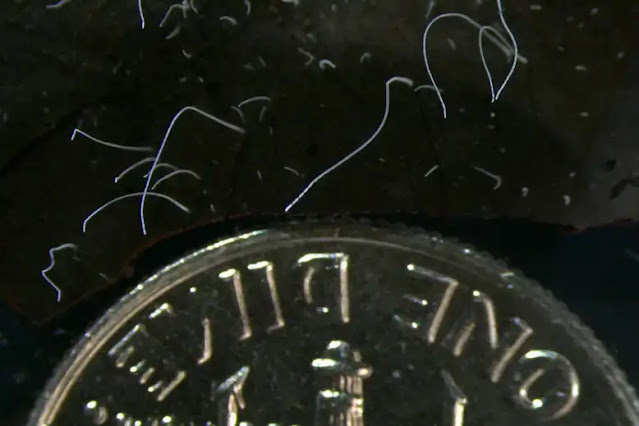.webp) |
| Thiomargarita Magnifica is visible without a microscope. Tyml, Tomas |
Most bacteria are only 2 micrometers long, but Thiomargarita Magnifica is thousands of times larger and far more complex.
The world's largest known bacteria have been discovered in the Caribbean's tropical mangroves of Guadeloupe. Each bacterium is about one centimeter long and exhibits structural complexity not previously seen in bacteria.
"I discovered long white filaments attached to sunken leaves of a mangrove tree in 2009 while collecting samples underwater." Because of their size, I initially thought they were some kind of eukaryote [animal, plant, or fungus], said Olivier Gros of the University of the French Antilles, Guadeloupe, at a press conference.
Most bacteria are about 2 micrometers long (0.0002 centimeters). Because the energy-carrying molecules they use to power themselves, known as ATP, are produced by enzymes embedded in the cell membrane, their size is limited. This means that bacteria must have a suitable surface-area-to-volume ratio in order to function. Growing larger also limits their ability to move around.
Having said that, we already knew bacteria could grow larger, with one species, Thiomargarita nelsonii, reaching 750 micrometers in length. This is still within the theoretical size limits imposed on bacteria.
Gros and his colleagues discovered that the new bacterium, Thiomargarita Magnifica, has a volume roughly 50 times that of T. nelsonii, defying the expected size limits.
"They grow much larger than what was thought to be the maximum possible size for bacteria," said team member Jean-Marie Volland at the press conference at the Lawrence Berkeley National Laboratory in California.
"It's the equivalent for us humans of meeting another human who is as tall as Mount Everest, so that was quite a surprise," Volland added.
The researchers discovered an extensive network of membranes - studded with ATP-producing enzymes - packed within the cell volume of T. Magnifica by imaging the bacteria. This allows them to meet their energy requirements despite their size.
Each bacterium has one end that anchors to solid surfaces, such as sunken leaves on the mangrove floor, while the rest of the body stretches up into the water. It's unclear how it attaches.
"I discovered them attached to oyster shells, leaves, and branches, as well as glass bottles, plastic bottles, and ropes," Gros explained. "I discovered the highest concentration of Thiomargarita Magnifica on plastic bags in mangroves."
The researchers believe the long and thin bacteria evolved to access sulfur in the mangrove sediments as well as oxygen in the seawater above, which they use to generate energy.
"They may be bridging the gap between these two chemical compartments, and they appear to be utilizing these chemical gradients to generate energy and fix carbon," Volland said.
The researchers discovered that T. Magnifica cells store their DNA and ribosomes, or protein-making machinery, inside sacs made of the cell membranes by labeling the membranes with a dye and imaging the bacteria. This is a characteristic found only in more complex eukaryotic cells like those found in plants and animals.
"Most bacterial cells have their DNA floating around freely within their cells," Volland explained. "These T. Magnifica compartments represent a new type of bacterial [cell compartment] that we named pepins, which means small seeds in fruits in French."
Despite its unusual characteristics, T. Magnifica shares many genetic similarities with members of the Thiomargarita bacterial group and fits comfortably within the current tree of life.
"We don't need to redesign the tree of life," said Tanja Woyke of the Lawrence Berkeley National Laboratory during a press conference.
"It's always exciting when a [unusual bacterium] is added to the microbial bestiary," says Paul Schavemaker of the University of Groningen in the Netherlands, who was not involved in the research. "Given its large volume and complex internal organization, T. Magnifica certainly expands what we imagine possible for prokaryotes [like bacteria] and blurs the lines between prokaryotes and eukaryotes."
"The study has a massive impact. Bacteria are small and simple, according to all microbiology textbooks. However, the findings described in this paper will fundamentally alter our perspective on these issues," says Gerard Muijzer of the University of Amsterdam.
"One of the challenges will be to cultivate the bacteria in pure or highly enriched cultures so that the physiology and biochemistry of the bacteria can be studied in-depth," Muijzer adds. "There's so much to learn about these tiny creatures."
Reference: Science, DOI: 10.1126/science.abb3634
